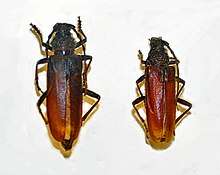Cerambyx welensii
Cerambyx welensii is a species of beetle in the family Cerambycidae (longhorn beetles).
| Cerambyx welensii | |
|---|---|
 | |
| Cerambyx welensii. Museum specimen | |
| Scientific classification | |
| Kingdom: | Animalia |
| Phylum: | Arthropoda |
| Class: | Insecta |
| Order: | Coleoptera |
| Family: | Cerambycidae |
| Genus: | Cerambyx |
| Species: | C. welensii |
| Binomial name | |
| Cerambyx welensii (Küster, 1846) | |
| Synonyms | |
| |
Subspecies
Subspecies include:[1]
- Cerambyx welensii centurio Czwalina, 1891
- Cerambyx welensii welensii Küster, 1846
Distribution
This species is widespread in Southern Europe and in the Near East . It is present in Albania, Bosnia and Herzegovina, Bulgaria, Croatia, France, Greece, Hungary, Italy, Jordan, Lebanon, Malta, Morocco, Portugal, Romania, Sicily, Slovakia, Slovenia, Spain, Syria, Tunisia, Morocco, Jordan, Lebanon, Israel and Azerbaijan.[2][1][3]
Description
Cerambyx welensii can reach a length of 25–58 millimetres (0.98–2.28 in).[4] These beetles have an elongated body. Antennae of males extend beyond the apex of the elytra by last three antennal segments. The basic color is brownish, with clearer apex of the elytra. Eltra are entirely covered by a thick, white to yellowish setae and have rounded apex. The pronotum shows a thorny tubercle on its sides.[4] This species is rather similat to Cerambyx carinatus.[1] and to Cerambyx cerdo.[5]
Biology
Larvae of these beetles are xylophagous. They mainly feed on downy oak (Quercus pubescens), evergreen oak (Quercus ilex) and cork oak (Quercus suber).[1] These longhorn beetle are considered a pest of oaks.[6] Females are polyandrous and males are polygynous.[6]
References
| Wikispecies has information related to Cerambyx welensii |
| Wikimedia Commons has media related to Cerambyx welensii. |
- Biolib
- Fauna europaea
- Cerambycoidea
- Parchi, foreste e Natura (in Italian)
- LIFE MIPP
- Torres-Vila LM, Mendiola-Diaz FJ, Conejo-Rodríguez Y, Sánchez-González Á. Reproductive traits and number of matings in males and females of Cerambyx welensii (Coleoptera: Cerambycidae) an emergent pest of oaks.